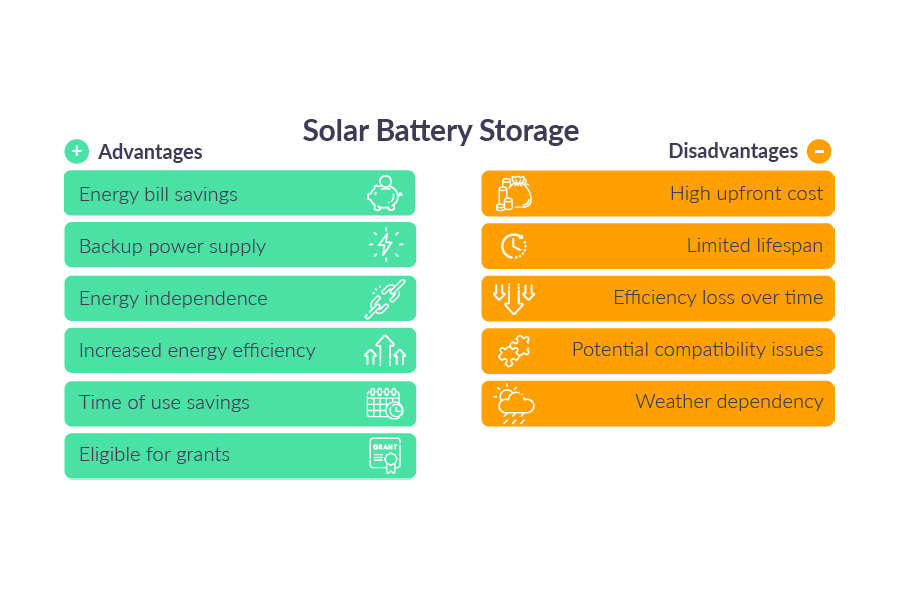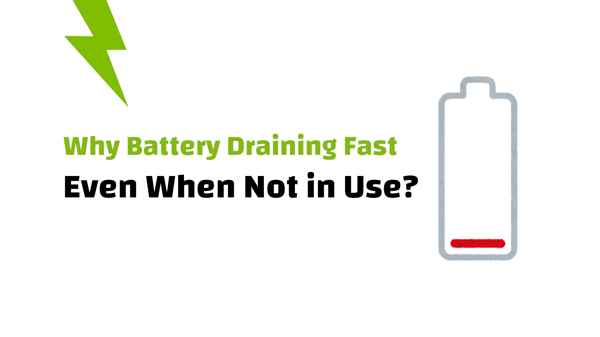Jakie są wady baterii słonecznych?
Baterie słoneczne to gorący temat, obiecująca niezależność energetyczna i moc zapasowa. Ale gdy weźmiesz pod uwagę tę znaczącą inwestycję, być może pytasz: Jaki jest haczyk? Czy są ukryte koszty, Problemy z wydajnością, lub inne wady, o których należy pamiętać? Wyraźne spojrzenie na potencjalne wady jest niezbędne do tworzenia mądrego, Pewna decyzja o Twojej przyszłości energetycznej.
Głównymi wadami baterii słonecznych są ich znaczny koszt z góry, Ich skończona żywotność (Wszystkie baterie z czasem degradują), Straty wydajności w obie strony (Nie wychodzisz 100% energii, którą wkładasz), i fizyczna przestrzeń, której potrzebują. Istnieją również szersze względy środowiskowe dotyczące ich produkcji i recyklingu na koniec życia. Jednakże, Ważne jest, aby wiedzieć, że nowoczesna technologia akumulatorów, szczególnie w eleganckim „baterii słonecznej na ścianie" systemy, Szybko postępuje, aby złagodzić wiele z tych wyzwań, poprawa wartości i wydajności każdego roku.

Na Gycx Solar, Wierzymy w przejrzystość. Zrozumienie zarówno profesjonalistów, jak i wad jest kluczowe. Chociaż są wyzwania, dla wielu ludzi, Korzyści z odporności energii i samowystarczalności słonecznej. Zajmijmy się największymi pytaniami na temat potencjalnych wad.
Ile lat trwa bateria słoneczna?
Jednym z najważniejszych problemów podczas inwestowania w baterię słoneczną jest jego żywotność. Chcesz mieć pewność, że bateria będzie trwać wystarczająco długo, aby zapewnić dobry zwrot z inwestycji. Jak długo możesz realistycznie oczekiwać? Odpowiedź różni się znacznie w zależności od makijażu chemicznego baterii.
Nowoczesny LFP (Fosforan żelaza litu) bateria słoneczna, Typ najczęściej występujący w dzisiejszym zaawansowanym bateria słoneczna na ścianie systemy, jest zazwyczaj zaprojektowany, aby trwać 10 Do 20 lata. Baterie te są często wspierane przez kompleksowe 10-letnie gwarancje, które gwarantują pewien poziom wydajności. W przeciwieństwie, starsze, tradycyjny Bateria ołowiowa Typy mają znacznie krótszą żywotność operacyjną, zwykle w zakresie 3 Do 7 lata, i wymagają częstszej wymiany.

Nurkuj głębiej: Zrozumienie długowieczności baterii (Chemia jest kluczowa)
Żywotność baterii jest mierzona na dwa sposoby: Cykl życiowy (Ile razy można go naładować i zwolnić) I Życie kalendarza (Ile lat trwa, zanim jego chemia naturalnie się degraduje).
- LFP (Fosforan żelaza litu) Baterie: Jest to wiodąca technologia magazynowania energii stacjonarnej, I nie bez powodu.
- Cykl życiowy: Baterie LFP oferują imponujące 3,000 Do 6,000+ Głębokie cykle, z niektórymi wysokiej jakości komórkami ocenianymi jeszcze bardziej. To sprawia, że są idealne do codziennego użytku z systemem panel słonecznych.
- Życie kalendarza: Ich stabilna chemia pozwala im trwać 10, 15, a nawet do 20 Wiele przed ich zdolnością znacznie się degraduje.
- Gwarancja: Renomowani producenci zazwyczaj zapewniają 10-letnią gwarancję, Często gwarantuje, że bateria zachowa przynajmniej 70% jego pierwotnej pojemności przechowywania do końca tego terminu.
- Baterie ołowiowe (Zalane, AGM, Żel): To jest starsze, bardziej tradycyjna technologia.
- Cykl życiowy: Znacznie niższe niż LFP, Zazwyczaj od 300 Do 1,000 cykle, W zależności od konkretnego rodzaju i tego, jak głęboko się rozładowano.
- Życie kalendarza: Ogólnie 3 Do 7 lata. Ciepło i głębokie cykl mogą to znacznie skrócić.
- Gwarancja: Zwykle znacznie krótszy, często w 1 do 5-letniego zasięgu.
Inne czynniki, takie jak temperatura robocza baterii (Wolą fajnie, Umiarkowany klimat) oraz jakość systemu System zarządzania baterią (BMS) odgryć także ogromną rolę w maksymalizacji życia. W Gycx Solar, Priorytetowo traktują długotrwałą technologię LFP, Tak jak ten znaleziony w nowoczesnych systemach montażu ściennego i serwerów, Aby zapewnić naszym klientom najlepszą długoterminową wartość i ponad dekadę niezawodnej usługi z inwestycji w magazynowanie energii.
Co odprowadza baterię słoneczną?
W baterii przechowywałeś czystą energię słoneczną - fantastyczne! Ale dokąd faktycznie zmierza ta energia? Zrozumienie, co „dreny" lub wykorzystuje moc z baterii słonecznej, jest kluczem do skutecznego zarządzania zużyciem energii w domu.
Podstawowy odpływ na baterii słonecznej to, rozmyślnie, zasilanie obciążeń elektrycznych domu lub firmy - Rzeczy takie jak światła, Twoja lodówka, komputery, Systemy HVAC, i inne urządzenia. Jednakże, są dwa inne, mniejsze odpływy, o których należy pamiętać: the własne zużycie energii w trybie trybuntera (Moc, której używa tylko po to, aby pozostać włączonym i gotowym) i bardzo stopniowe, naturalny samorozładowanie baterii w czasie.

Nurkuj głębiej: Śledzenie zapisanej energii
Rozbijmy się tam, gdzie idzie energia:
- Twoje obciążenia elektryczne: To jest główne zadanie baterii - zapewnienie mocy, gdy panele słoneczne nie produkują (w nocy) lub gdy siatka się nie spowalnia. Każde światło, na którym włączasz, Każde urządzenie, które prowadzisz, pobiera zasilanie z baterii. Im więcej używasz, Im szybciej odpływa.
- Zużycie w trybie gotowości falownika (lub obciążenie biegu jałowego): Twój falownik słoneczny (w szczególności hybrydowy falownik podłączony do baterii) musi pozostać ”" 24/7 być gotowym do natychmiastowego dostarczenia zasilania prądu przemiennego do domu. To zużywa małą, ale stałą moc z baterii, Nawet jeśli nie masz urządzeń. Może to wahać się od 20 Watts do końca 100 Watts w zależności od modelu falownika. W ciągu 12 godzin, To małe obciążenie może skorzystać z zauważalnej ilości energii (NP., Używa obciążenia gotowości 50W 0.6 KWH Over 12 godziny).
- Samozadowolenie: Wszystkie akumulatory powoli tracą ładunek z czasem z powodu wewnętrznych procesów chemicznych. Jest to nieuniknione. Jednakże, Wskaźnik samozadowolenia różni się znacznie w zależności od chemii.
- Baterie LFP: Mieć bardzo niski wskaźnik samozadowolenia, zazwyczaj tylko 1-3% na miesiąc.
- Baterie ołowiowe: Mieć znacznie wyższy wskaźnik samozadowolenia, które mogą być 3-20% miesięcznie w zależności od określonego rodzaju i temperatury otoczenia.
To niskie samozadowolenie jest kolejną kluczową zaletą technologii LFP stosowanej w nowoczesnych systemach akumulatorów słonecznych na ścianie.
- Utrata wydajności w obie strony: Chociaż nie jest „odpływem" W ten sam sposób, Pamiętaj, że pewna energia jest tracona jako ciepło podczas ładowania i rozładowywania akumulatora. Bateria LFP może mieć wydajność w obie strony 90-95%, znaczenie dla każdego 10 kWh, który włożyłeś, dostajesz 9.0-9.5 KWH z użytecznej energii.
Zrozumienie tych drenażów pomaga poprawnie rozmiar systemu i zarządzanie zużyciem energii, aby jak najlepiej wykorzystać każdy przechowywany kilowatogodzinę.
Dlaczego moja bateria słoneczna jest tak szybko wyczerpuje się w nocy?
Jednym z najczęstszych problemów, które słyszymy od nowych właścicieli baterii słonecznych, jest, „Czuję, że moja bateria wyczerpuje się szybciej niż się spodziewałem z dnia na dzień!" Jeśli to się z tobą dzieje, Nie martw się - zwykle istnieją logiczne wyjaśnienia.
Bateria słoneczna może wydawać się szybko spływać w nocy przede wszystkim z powodu wyższe niż oczekiwano zużycie energii (z urządzeń, Systemy HVAC, lub „obciążenia fantomowe”). Inne przyczyny mogą obejmować Znaczna moc rezerwowa czerpią z twojego falownika, mając Układ akumulatorowy, który jest niewymiarowy dla twoich rzeczywistych potrzeb, Lub, W niektórych przypadkach, jakiś starzejący się bateria, która naturalnie straciła część pierwotnej pojemności przechowywania.

Nurkuj głębiej: Diagnozowanie szybkiego baterii
Zbadajmy prawdopodobnych winowajców:
- Wysokie obciążenia nocne: To najczęstszy powód. Możesz być zaskoczony, ile energii zużywa Twój dom, gdy śpisz.
- Główne urządzenia: Czy Twój system HVAC działa? A co z pompą basenową, gorąca podgrzewacz wody na timerze, lub ładowanie pojazdu elektrycznego? To są bardzo duże ładunki.
- "Fantom" lub „wampir" Masa: Wiele elektroniki (Telewizory, skrzynki kablowe, Konsole do gier, mikrofale) Narysuj niewielką moc, nawet gdy „wyłącz" Ale podłączony. Indywidualnie są małe, Ale razem mogą się sumować.
- Obciążenie trybu gotowości falownika: Jak wspomniano wcześniej, Twój falownik używa mocy tylko do bycia włączonym. Podczas gdy mały, To ciągłe losowanie przyczynia się do spustu na noc.
- Niewymiarowa bateria: Pojemność baterii (kWh) może być po prostu zbyt małe, aby pokryć całkowite zużycie energii z dnia na dzień. Jeśli używasz 8 kWh z dnia na dzień, ale ma tylko 10 bateria kWh z 90% DoD (9 KWH użyteczny), Będzie prawie pusty do rana. Właściwe rozmiarze jest kluczowe.
- Zdegradowane zdrowie baterii: Jeśli bateria ma kilka lat, straci część pierwotnych pojemności z powodu naturalnej degradacji. Starsza bateria, która została kiedyś oceniona 10 KWH może teraz tylko trzymać 8 kWh, Więc naturalnie poczuje się, jakby szybciej wyczerpuje. Wiele nowoczesnych systemów z dobrym BMS może zgłosić się na temat stanu zdrowia baterii (Soh1. ).
- Niepoprawny stan ładunku (SoC) Czytanie: W rzadkich przypadkach, BMS systemu może być błędnie kalibrowany i zgłaszać, że bateria jest 100% Pełne, gdy nie jest, prowadząc do postrzeganego szybkiego spadku. Można to czasem naprawić, umożliwiając przeglądanie akumulatora przez cykl pełnego naładowania/rozładowania.
Gycx Solar Story: „Pomogliśmy klientowi, który był zdziwiony przez szybką baterię. Po przejrzeniu danych monitorowania energii, Odkryliśmy stare, Nieefektywna zamrażarka w ich garażu często jeździła na rowerze przez całą noc, Za pomocą kilku kWh. Zastępując go nowym, model energooszczędny, Ich bateria z łatwością trwała do rana z dużą mocą do stracenia."
Czy możesz przeładować baterię słoneczną?
Z potężnym słońcem promieniem paneli słonecznych, Powszechnym i ważnym problemem jest to, czy cała ta energia może potencjalnie „przeładować" i uszkodzą drogi bank baterii. Czy to prawdziwe ryzyko w dzisiejszej technologii?
W każdym nowoczesnym, profesjonalnie zainstalowany system akumulatorów słonecznych, takie jak bateria słoneczna na ścianie jednostka, praktycznie niemożliwe jest przeciążenie baterii. Systemy te mają wiele warstw ochrony. System System zarządzania baterią (BMS) i Kontroler ładunku słonecznego (który jest zwykle zintegrowany z hybrydowym falownikiem) Współpracuj, aby stale monitorować stan ładowania baterii i automatycznie zatrzyma się lub radykalnie zmniejszyć prąd ładowania po pełnym baterii. Zapobiega to przeładowaniu i chroni baterię przed uszkodzeniem.

Nurkuj głębiej: Siatka bezpieczeństwa nowoczesnych systemów ładowania
Oto jak twój system chroni się przed nadmiernym ładowaniem:
- Kontroler ładunku słonecznego / Inwerter hybrydowy: To główny menedżer procesu ładowania baterii. Nie po prostu ślepo wysyła zasilanie z paneli słonecznych do baterii. Zamiast, używa wyrafinowanego wieloetapowego profilu ładowania (Często nazywane luzem, Wchłanianie, i etapy pływaków) To jest specjalnie zaprogramowane dla chemii baterii (NP., LFP lub ołowiany kwas). Kiedy kontroler wyczuwa, że napięcie akumulatora osiągnęło „pełne" lub „Absorpcja" punkt zadany, utrzymuje napięcie stabilne i zwęża prąd ładowania. Po pełnym naładowaniu baterii, Zatrzymuje wysyłanie prądu lub przełącznika na float o bardzo niskiej mocy" tryb tylko po to, aby było to uzupełnione z samodzielnym rozładowaniem.
- System zarządzania baterią (BMS): To jest ostateczna i najbardziej krytyczna linia obrony. BMS jest ograniczony do monitorowania napięcia każdej jednej komórki (lub grupa komórek) W pakiecie baterii. Jeśli, z jakiegokolwiek powodu, Kontroler ładowania miał zawieść lub napięcie komórki miało przekroczyć maksymalny bezpieczny limit, BMS ma uprawnienia do podjęcia działań ochronnych. Może wysłać sygnał do falownika, aby natychmiast zaprzestać ładowania, lub w wielu przypadkach, Może fizycznie otworzyć wewnętrzny stycznik lub przekaźnik, aby odłączyć akumulator od źródła ładowania, skutecznie zapobieganie scenariuszowi nadmiernego ładowania.
- Kiedy przeładowuje ryzyko? Ryzyko istnieje przede wszystkim w słabo zaprojektowanym, Systemy DIY, w których komponenty są niedopasowane - na przykład, używając prostego, nieuregulowana ładowarka lub kontroler ładowania, który nie jest prawidłowo skonfigurowany dla określonego napięcia i chemii baterii litowej, do której jest podłączony.
W Gycx Solar, Używamy wyłącznie wysokiej jakości, Zintegrowane systemy, takie jak nowoczesne baterie słoneczne lub dobrze zindywidualne roztwory montażu, w których akumulator, BMS, a falownik jest zaprojektowany i certyfikowany do współpracy w doskonałej harmonii. Zapewnia to, że systemy naszych klientów są nie tylko wydajne, ale także zasadniczo bezpieczne przed problemami takimi jak przeładowywanie.
Podczas gdy baterie słoneczne mają wady, takie jak koszty z góry i skończona żywotność, Nowoczesna technologia-szczególnie w systemach akumulatorów słonecznych opartych na ścianie LFP-sprawiła, że były bardziej trwałe, dłużej, i bezpieczniej niż kiedykolwiek wcześniej. Rozumiejąc ich cechy i współpracując z doświadczonym instalatorem, Te wady można skutecznie zarządzać, czyniąc z nich wartość inwestycji w bezpieczeństwo energetyczne i niezależność.
Jeśli masz więcej pytań na temat opcji baterii słonecznej lub chcesz zbadać, w jaki sposób rozwiązanie baterii na ścianie może przynieść korzyści Twojemu domowi lub firmie, Zespół Gycx Solar jest gotowy do pomocy. Skontaktuj się z nami w celu konsultacji ekspertów!
Zrozum informacyjną terminologię baterii w celu lepszego zrozumienia zdrowia i oceny baterii litowej. Pomoże to wybrać produkt, który lepiej odpowiada Twoim potrzebom. ↩
